Abstract
The authors measured polychlorinated biphenyls (PCBs) and dichlorodiphenyl dichloroethene (DDE) in maternal serum, cord blood, placenta, and serial samples of breast milk from 868 women. Almost all samples of breast milk showed detectable levels of both chemicals. Overall, values for DDE in this study are within the range of those found previously, whereas those for PCBs are somewhat higher. Possible causes of variation in levels were investigated. For DDE, older women, Black women, cigarette smokers, and women who consumed sport fish during pregnancy had higher levels; only age and race showed large effects. For PCBs, older women, women who regularly drink alcohol, and primiparae had higher levels. In addition, both chemicals showed modest variation across occupational groupings. Casual exposure to a PCB spill did not result in chemical levels different from background. In general, women have higher levels in their first lactation and in the earlier samples of a given lactation, and levels decline both with time spent breast-feeding and with number of children nursed. These striking declines are presumably a measure of exposure to the child.
Full text
PDF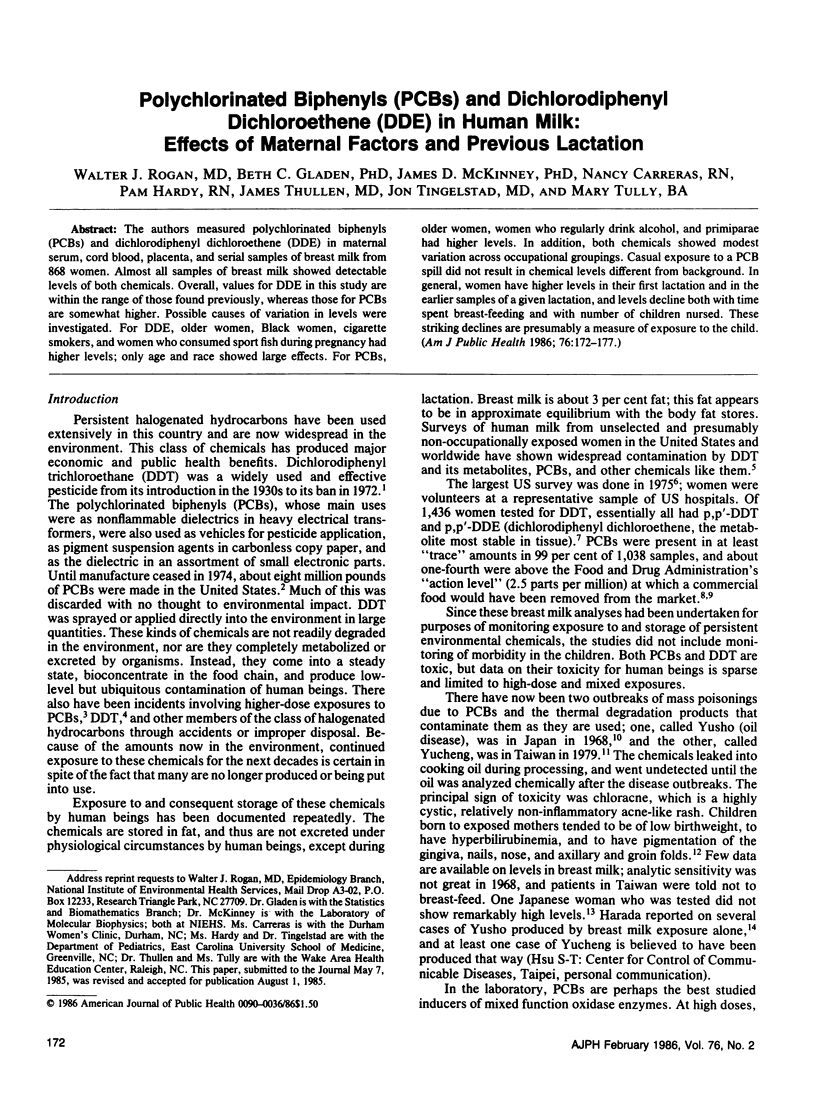
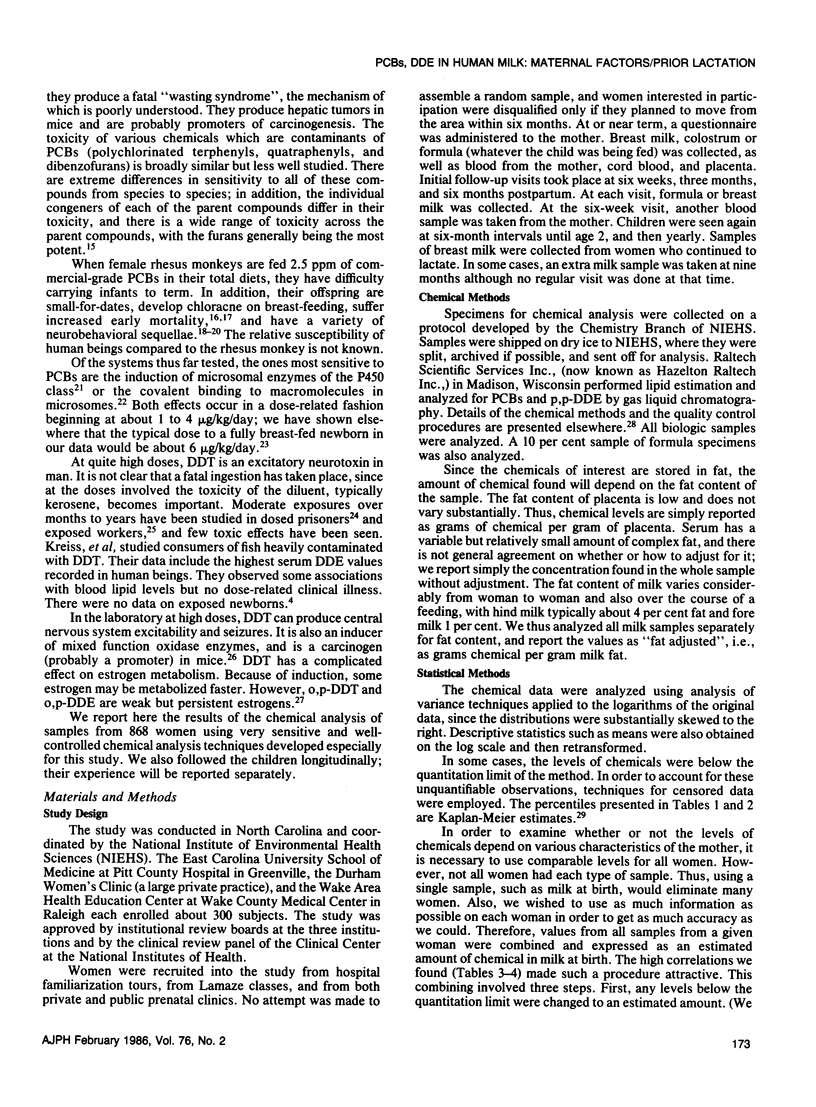
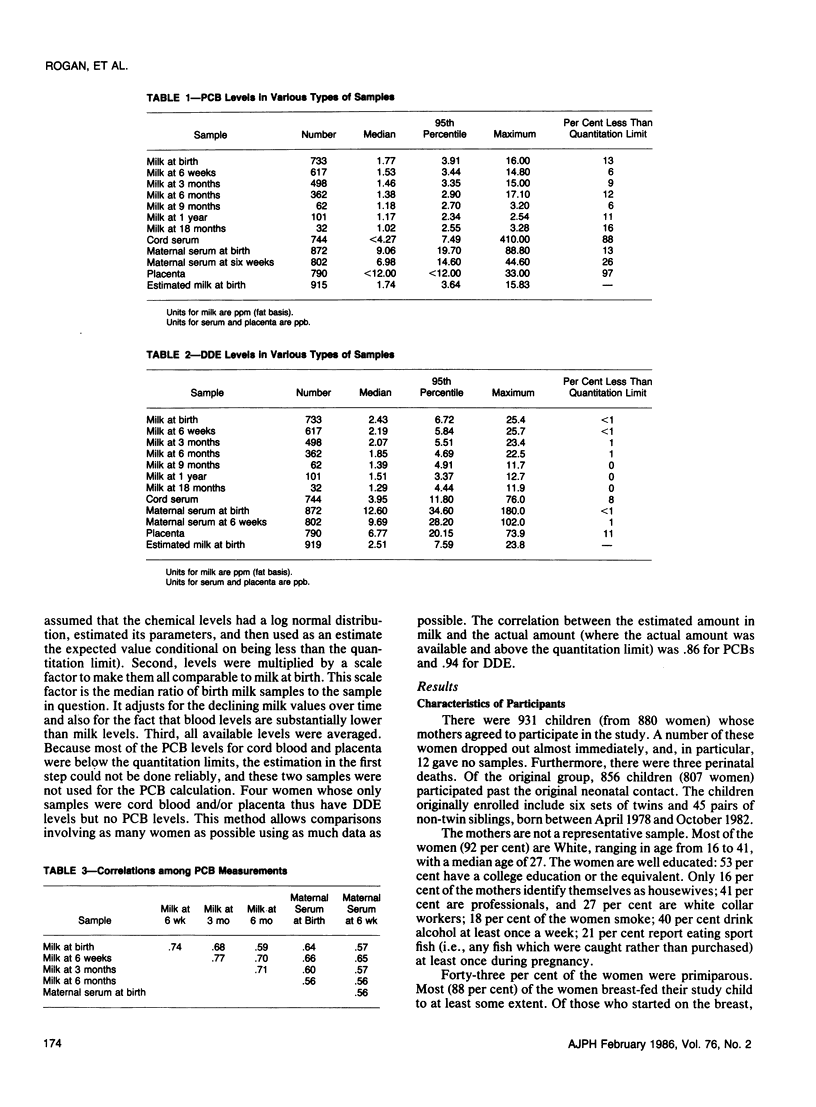
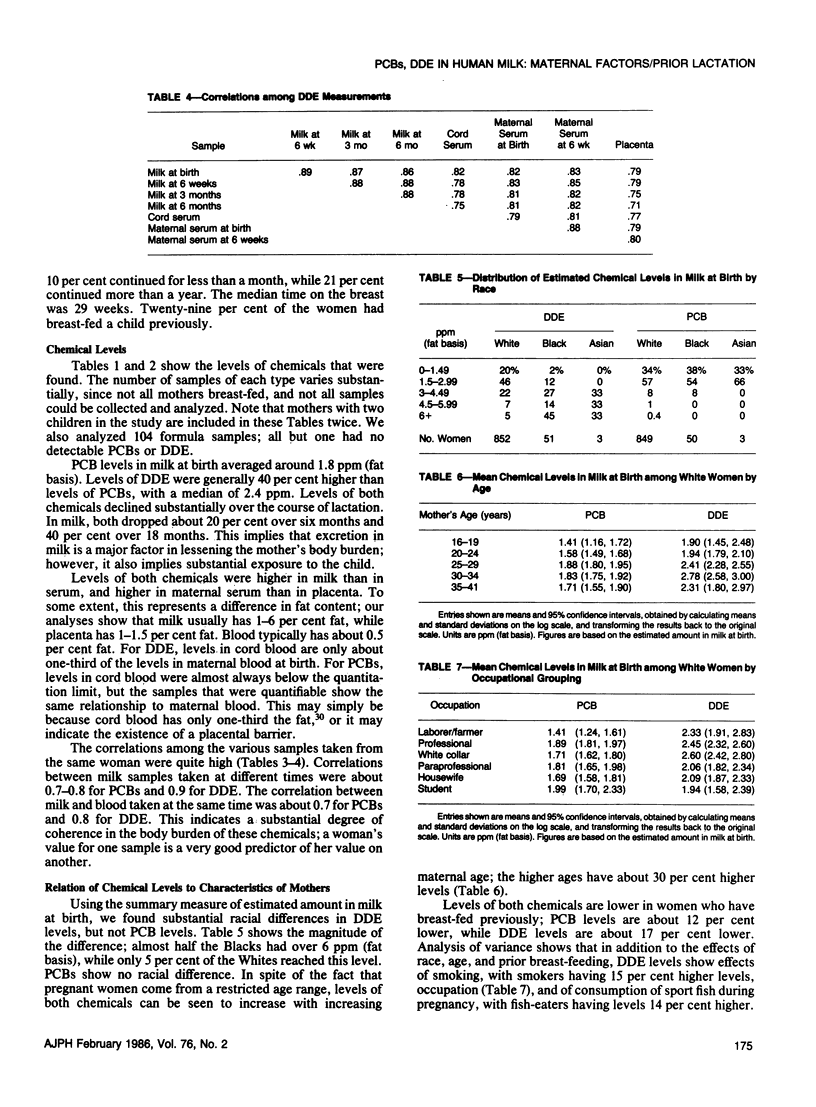
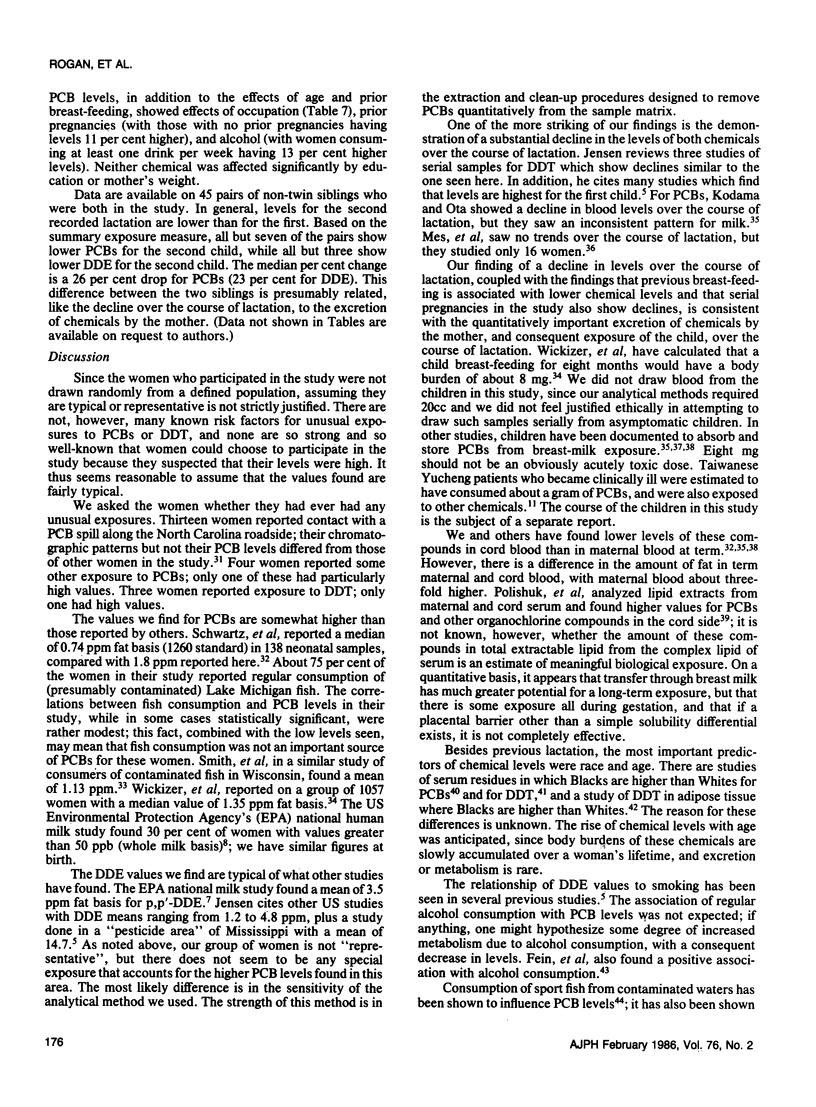
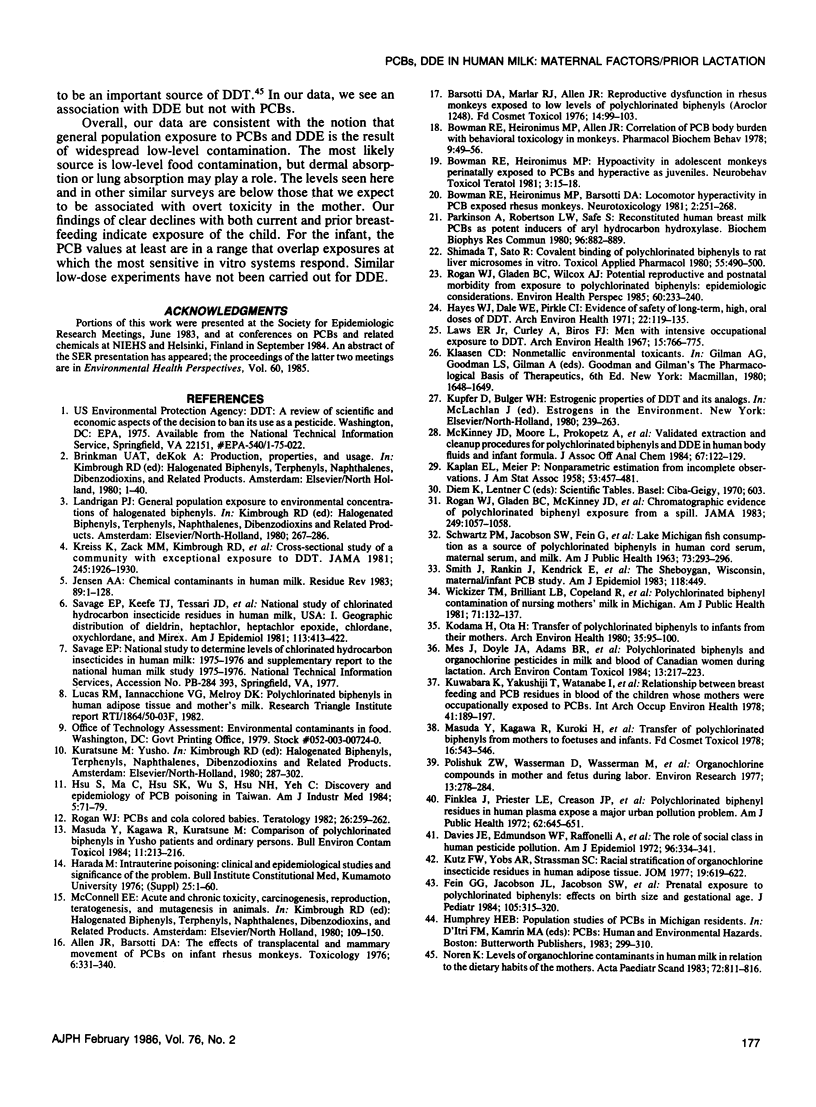
Selected References
These references are in PubMed. This may not be the complete list of references from this article.
- Allen J. R., Barsotti D. A. The effects of transplacental and mammary movement of PCBs on infant rhesus monkeys. Toxicology. 1976 Nov-Dec;6(3):331–340. doi: 10.1016/0300-483x(76)90037-8. [DOI] [PubMed] [Google Scholar]
- Barsotti D. A., Marlar R. J., Allen J. R. Reproductive dysfunction in rhesus monkeys exposed to low levels of polychlorinated biphenyls (Aoroclor 1248). Food Cosmet Toxicol. 1976 Apr;14(2):99–103. doi: 10.1016/s0015-6264(76)80251-9. [DOI] [PubMed] [Google Scholar]
- Bowman R. E., Heironimus M. P., Allen J. R. Correlation of PCB body burden with behavioral toxicology in monkeys. Pharmacol Biochem Behav. 1978 Jul;9(1):49–56. doi: 10.1016/0091-3057(78)90012-6. [DOI] [PubMed] [Google Scholar]
- Bowman R. E., Heironimus M. P., Barsotti D. A. Locomotor hyperactivity in PCB-exposed rhesus monkeys. Neurotoxicology. 1981 Oct;2(2):251–268. [PubMed] [Google Scholar]
- Davies J. E., Edmundson W. F., Raffonelli A., Cassady J. C., Morgade C. The role of social class in human pesticide pollution. Am J Epidemiol. 1972 Nov;96(5):334–341. doi: 10.1093/oxfordjournals.aje.a121464. [DOI] [PubMed] [Google Scholar]
- Fein G. G., Jacobson J. L., Jacobson S. W., Schwartz P. M., Dowler J. K. Prenatal exposure to polychlorinated biphenyls: effects on birth size and gestational age. J Pediatr. 1984 Aug;105(2):315–320. doi: 10.1016/s0022-3476(84)80139-0. [DOI] [PubMed] [Google Scholar]
- Finklea J., Priester L. E., Creason J. P., Hauser T., Hinners T., Hammer D. I. Polychlorinated biphenyl residues in human plasma expose a major urban pollution problem. Am J Public Health. 1972 May;62(5):645–651. doi: 10.2105/ajph.62.5.645. [DOI] [PMC free article] [PubMed] [Google Scholar]
- Hayes W. J., Jr, Dale W. E., Pirkle C. I. Evidence of safety of long-term, high, oral doses of DDT for man. Arch Environ Health. 1971 Jan;22(1):119–135. doi: 10.1080/00039896.1971.10665822. [DOI] [PubMed] [Google Scholar]
- Hsu S. T., Ma C. I., Hsu S. K., Wu S. S., Hsu N. H., Yeh C. C. Discovery and epidemiology of PCB poisoning in Taiwan. Am J Ind Med. 1984;5(1-2):71–79. [PubMed] [Google Scholar]
- Jensen A. A. Chemical contaminants in human milk. Residue Rev. 1983;89:1–128. doi: 10.1007/978-1-4612-5601-4_1. [DOI] [PubMed] [Google Scholar]
- Kodama H., Ota H. Transfer of polychlorinated biphenyls to infants from their mothers. Arch Environ Health. 1980 Mar-Apr;35(2):95–100. [PubMed] [Google Scholar]
- Kreiss K., Zack M. M., Kimbrough R. D., Needham L. L., Smrek A. L., Jones B. T. Cross-sectional study of a community with exceptional exposure to DDT. JAMA. 1981 May 15;245(19):1926–1930. [PubMed] [Google Scholar]
- Kutz F. W., Yobs A. R., Strassman S. C. Racial stratification of organochlorine insecticide residues in human adipose tissue. J Occup Med. 1977 Sep;19(9):619–622. [PubMed] [Google Scholar]
- Kuwabara K., Yakushiji T., Watanabe I., Yoshida S., Koyama K., Kunita N., Hara I. Relationship between breast feeding and PCB residues in blood of the children whose mothers were occupationally exposed to PCBs. Int Arch Occup Environ Health. 1978 May 12;41(3):189–197. doi: 10.1007/BF00572891. [DOI] [PubMed] [Google Scholar]
- Laws E. R., Jr, Curley A., Biros F. J. Men with intensive occupational exposure to DDT. A clinical and chemical study. Arch Environ Health. 1967 Dec;15(6):766–775. doi: 10.1080/00039896.1967.10664995. [DOI] [PubMed] [Google Scholar]
- Masuda Y., Kagawa R., Kurantsune M. Comparison of polychlorinated biphenyls in yusho patients and ordinary persons. Bull Environ Contam Toxicol. 1974 Mar;11(3):213–216. doi: 10.1007/BF01685094. [DOI] [PubMed] [Google Scholar]
- Masuda Y., Kagawa R., Kuroki H., Kuratsune M., Yoshimura T., Taki I., Kusuda M., Yamashita F., Hayashi M. Transfer of polychlorinated biphenyls from mothers to foetuses and infants. Food Cosmet Toxicol. 1978 Dec;16(6):543–546. doi: 10.1016/s0015-6264(78)80221-1. [DOI] [PubMed] [Google Scholar]
- McKinney J. D., Moore L., Prokopetz A., Walters D. B. Validated extraction and cleanup procedures for polychlorinated biphenyls and DDE in human body fluids and infant formula. J Assoc Off Anal Chem. 1984 Jan-Feb;67(1):122–129. [PubMed] [Google Scholar]
- Mes J., Doyle J. A., Adams B. R., Davies D. J., Turton D. Polychlorinated biphenyls and organochlorine pesticides in milk and blood of Canadian women during lactation. Arch Environ Contam Toxicol. 1984 Mar;13(2):217–223. doi: 10.1007/BF01055879. [DOI] [PubMed] [Google Scholar]
- Norén K. Levels of organochlorine contaminants in human milk in relation to the dietary habits of the mothers. Acta Paediatr Scand. 1983 Nov;72(6):811–816. doi: 10.1111/j.1651-2227.1983.tb09821.x. [DOI] [PubMed] [Google Scholar]
- Parkinson A., Robertson L. W., Safe S. Reconstituted human breast milk PCBs as potent inducers of aryl hydrocarbon hydroxylase. Biochem Biophys Res Commun. 1980 Sep 30;96(2):882–889. doi: 10.1016/0006-291x(80)91438-2. [DOI] [PubMed] [Google Scholar]
- Polishuk Z. W., Wassermann D., Wassermann M., Cucos S., Ron M. Organochlorine compounds in mother and fetus during labor. Environ Res. 1977 Apr;13(2):278–284. doi: 10.1016/0013-9351(77)90104-9. [DOI] [PubMed] [Google Scholar]
- Rogan W. J., Gladen B. C., McKinney J. D., Albro P. W. Chromatographic evidence of polychlorinated biphenyl exposure from a spill. JAMA. 1983 Feb 25;249(8):1057–1059. [PubMed] [Google Scholar]
- Rogan W. J., Gladen B. C., Wilcox A. J. Potential reproductive and postnatal morbidity from exposure to polychlorinated biphenyls: epidemiologic considerations. Environ Health Perspect. 1985 May;60:233–239. doi: 10.1289/ehp.8560233. [DOI] [PMC free article] [PubMed] [Google Scholar]
- Rogan W. J. PCBs and cola-colored babies: Japan, 1968, and Taiwan, 1979. Teratology. 1982 Dec;26(3):259–261. doi: 10.1002/tera.1420260307. [DOI] [PubMed] [Google Scholar]
- Savage E. P., Keefe T. J., Tessari J. D., Wheeler H. W., Applehans F. M., Goes E. A., Ford S. A. National study of chlorinated hydrocarbon insecticide residues in human milk, USA. I. Geographic distribution of dieldrin, heptachlor, heptachlor epoxide, chlordane, oxychlordane, and mirex. Am J Epidemiol. 1981 Apr;113(4):413–422. doi: 10.1093/oxfordjournals.aje.a113109. [DOI] [PubMed] [Google Scholar]
- Schwartz P. M., Jacobson S. W., Fein G., Jacobson J. L., Price H. A. Lake Michigan fish consumption as a source of polychlorinated biphenyls in human cord serum, maternal serum, and milk. Am J Public Health. 1983 Mar;73(3):293–296. doi: 10.2105/ajph.73.3.293. [DOI] [PMC free article] [PubMed] [Google Scholar]
- Shimada T., Sato R. Covalent binding of polychlorinated biphenyls to rat liver microsomes in vitro: nature of reactive metabolites and target macromolecules. Toxicol Appl Pharmacol. 1980 Sep 30;55(3):490–500. doi: 10.1016/0041-008x(80)90051-4. [DOI] [PubMed] [Google Scholar]
- Wickizer T. M., Brilliant L. B., Copeland R., Tilden R. Polychlorinated biphenyl contamination of nursing mothers' milk in Michigan. Am J Public Health. 1981 Feb;71(2):132–137. doi: 10.2105/ajph.71.2.132. [DOI] [PMC free article] [PubMed] [Google Scholar]


